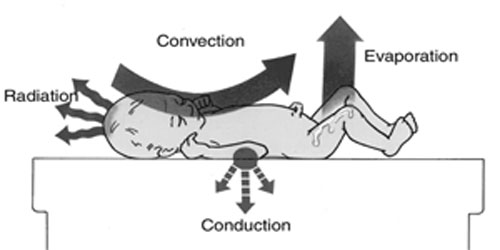7.4.3 How do newborns lose heat?
The mechanisms of how the newborn loses heat are summarised in Figure 7.5, and described below.

Convection. This is the loss of heat from the newborn's skin to the surrounding air. Newborns lose a lot of heat by convection when exposed to cold air or draughts.
Conduction. This is the loss of heat when the newborn lies on a cold surface. Newborns lose heat by conduction when placed naked on a cold table, weighing scale or are wrapped in a cold blanket or towel.
Evaporation. This is the loss of heat from a newborn's wet skin to the surrounding air. Newborns lose heat by evaporation after delivery or after a bath. Even a newborn in a wet nappy can lose heat by evaporation.
Radiation. This is the loss of heat from a newborn's skin to distant cold objects, such as a cold window or wall etc.
Finally, knowing that the newborn can lose heat by the four mechanisms described above, you should counsel the mother to avoid exposing the baby to drafts. Counsel her that before she removes the baby's clothes for a bath, close all doors and windows; cover the wet baby and dry him or her quickly.
Stop reading for a moment and think of your own experience in your community. Have you seen situations when mothers were in danger of letting their baby lose heat in any of the ways described above?
7.4.2 When are newborns at greatest risk of hypothermia?
